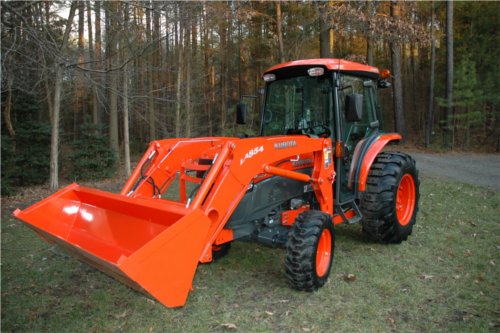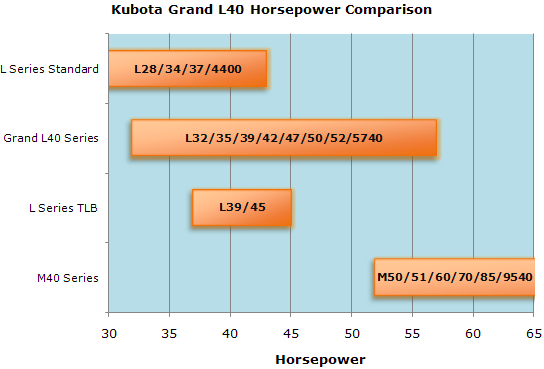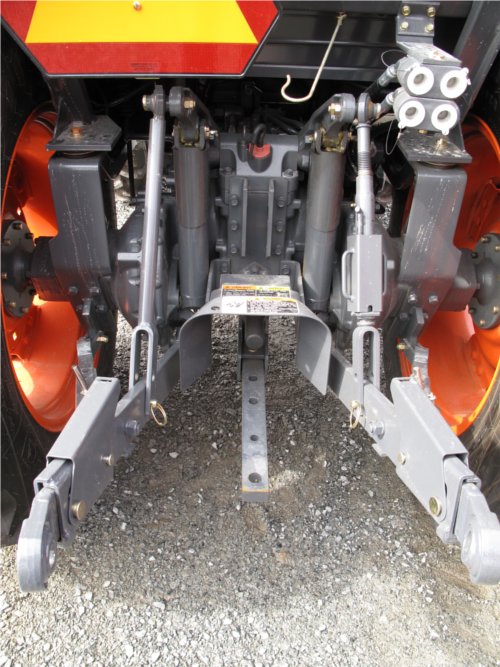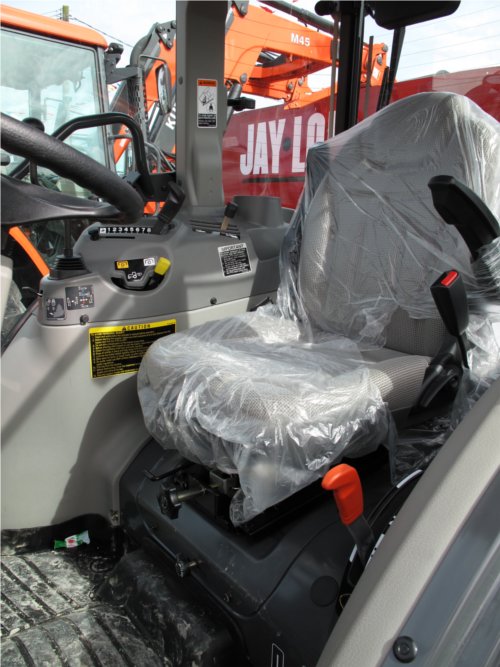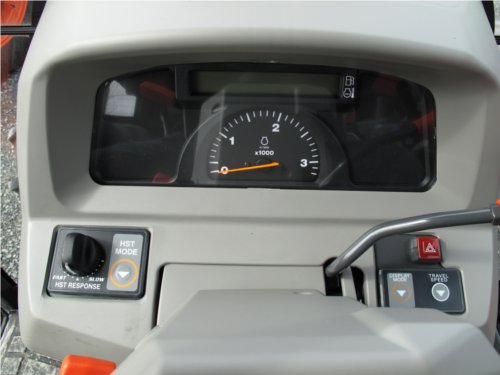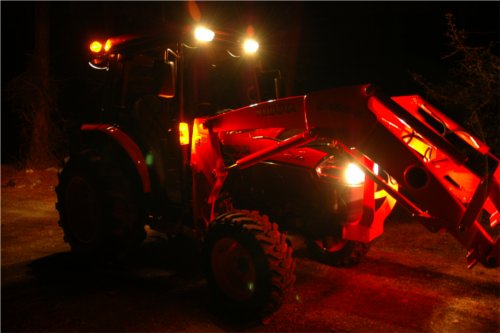An Overview of Kubota’s Grand L40 Series
Today we take a look at Kubota’s popular Grand L40 Series lineup and also share with you some snapshots sent in from OrangeTractorTalks readers. We want folks to know that we appreciate not just Kubota’s smaller compact tractors but also their larger offerings as well. In recent years Kubota has put serious effort into expanding their larger horsepower lineup by introducing models such as the MX100 or MX135. The Grand L40s contain no 100+ horsepower monsters but they certainly hold their own.
Series Overview
Introduced in early 2007, the Grand L40 Series is crowned by the L5740. Others in the family include the L3240, L3540, L3940, L4240, L4740, L5040 and L5240 ranging from 32 to 57 horsepower for the L5740.
The next size down from the Grand L40s are the standard L Series models such as the L2800, L3400, L3700 or L4400. These models tend to be simpler to operate, have no cab option, and have fewer fancy features when compared to a Grand L40 – and their pricing reflects that. They are still very capable Kubotas and represent very good tractor value.
If 57 horsepower is not enough for you the next stop is an M Series, most likely an M40 Series where power starts at 52 horsepower and stops just shy of the magic 100 at 95 horsepower for the M9540.
Two “brother” tractors to the Grand L40s are the specialty TLB models, the L39 and the larger L45 which come equipped with a loader and backhoe as standard equipment. These two TLBs share a lot of the features and technology from the Grand L40s that we will get to in a moment.
Engine
All Grand L40s use Kubota’s latest interim Tier IV compliant 4 cylinder diesel engines manufactured in their Tsukuba, Japan engine plant. The Grand L40s powerplants belong to the 03 Engine Series which uses Kubota’s own TVCS (Three Vortex Combustion System) combustion chamber design. TVCS which means lower operating noise, shorter plug preheat times and most importantly, compliance with the United State’s EPA diesel engine emission requirements.
Five engine models cover the eight model lineup with natural aspiration giving way to turbochargers for the L50/52/5740s which share the V2403. Maximum operating spec varies between 2700 and 2800RPM.
Mechanical and PTO
4WD, hydrostatic power steering, halogen lights, rear differential lock, wet disc brakes and parking brake are standard across the line except for the entry level L3240 which comes with 2WD. Mid PTOs are optional if you are interested in running a snow blower or perhaps the 72″ RC72-38 mid-mount mower. A live independent PTO clutch permits individual control over engaging the mid and rear PTOs.
PTO output ranges from 25 to 50 horsepower – plenty enough to drive most implements around the acreage or tree farm. Telescoping lower link arms are standard equipment and 3-point lift cylinders significantly boost lift capacity of the hitch.
Transmissions
Three transmission choices are available. The standard 8 Forward/8 Reverse FST (fully synchronized transmission), with GST or 3-speed HST transmissions optional on entry/mid level models and standard equipment on the L50/52/5740s. The entire Grand 40 lineup has access to a HST transmission if you so desire.
HST Plus
New for the Grand L40s is what Kubota calls HST Plus. The usual HST pump supplies oil to a new 2-stage (high/low) drive motor which is electronically controlled depending on the operator’s settings, the engine RPM, the HST pedal position and the load sensors. All of these features make using the HST a bit more user friendly in addition to helping overcome some of the most common problems of stalling, jerking or bogging down when an implement “digs in”.
Messick’s has an excellent overview of HST Plus along with videos which is required reading if you are considering adding a Grand L40 to your collection.
The basics features of HST Plus are summarized as:
- HST Response Control – the HST pump is modulated according to 1 of 13 fast/slow settings. The result is smoothing out starts and stops when set to slow or increased responsiveness on HST pedal directional changes when set to fast. Inexperienced or new operators have a tendency to be quick on the HST pedal so a slower setting here helps build confidence.
- Stall Guard – a marketing name for load sensing. Power to the wheels is constantly monitored to prevent or reduce the likelihood of engine stalling or HST bypass when moving over terrain with heavy loads or digging into a pile. These two videos below demonstrate what it looks like to dig into a pile with Stall Guard disabled versus enabled.
- Hydro Dual Speed (H-DS) – the 2 stage drive motor is switched between high/low settings either manually by the operator or automatically by the computer. In manual mode, if the operator knows the engine will become bogged down, they can use a lever on the steering column to switch the drive motor from high to low settings – effectively trading off 40% travel speed for a 60% increase in torque. Automatic mode leaves the switching between high/low (speed vs. torque) up to the electronics – automatic up/down shifts will occur depending on the situation.
- Auto Throttle Advance – links engine and travel speeds, similar to the experience of driving a vehicle equipped with an automatic transmission. It does this by letting the HST pedal dictate engine speed and the electronics match up the HST pump and 2 stage drive motor.
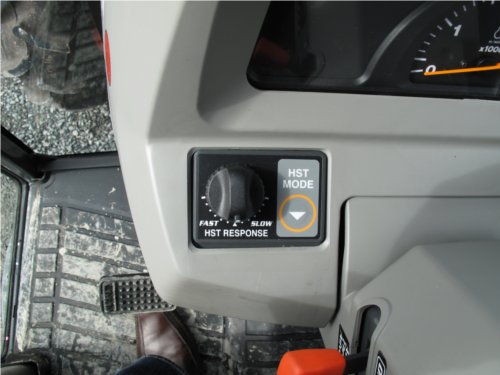
HST Response Control provides 13 settings of HST pedal response. Slow dampens starts/stops whereas fast increases responsiveness of pedal directional changes.
HST Plus can also be found on Kubota’s L45 and M59 TLBs.
Grand Cab
Grand Cab is Kubota’s trademark for their very well appointed cabs that sit atop all of this heavy machinery. Some of Kubota’s literature describes these glass bubbles as “luxury” enclosures which is hard to disagree with when you hear what they can pack into it:
- wide cloth reclining seat with arm-rests, springs and seat belt
- wide rubber-cushion foot platform
- air conditioning and heater with 7 adjustable vents and 2 zone heating – one zone for the operator’s body and another for his/her feet
- front and rear work lights
- CD/cassette/radio
- cup holder
- 12V power
- various storage pouches
- interior dome light
- front wiper
- front, corner and rear window defoggers
- rear corner windows and rear window that open to allow air to circulate
- tinted glass
- side mirrors
- tilt steering wheel
- computerized information panel (IntelliPanel)
Sitting in the cab of the L5740 you cannot help but want to touch all of the controls, knobs and begin making various adjustments and tweaks. Unless you go cab-less, the head room is unmatched, and despite the goodies crammed into the cab you never feel crowded. A person could get real comfortable in this cab whilst blading a few feet of snow out of the driveway.
Pricing
As of September 2010, prices range from $21,000CAD for the entry 2WD L3240 to $43,000+ for the L5740 with the Grand Cab. The cab option itself is a $10,000 touch and once you add on helpful extras like the LA854 front end loader or BH92 backhoe, a fully appointed L5740 would cost well into the $50-55,000+ mark.
One Reader’s Buying Decision
Now that we know approximately what a Grand L40 is and what you get for your money, why not find out more as to what goes into a buying decision for such a model.
OrangeTractorTalks reader Marshall Klinefelter sent us a few night shots of his L5740 at our request and also gave us some insight into his purchasing decision.
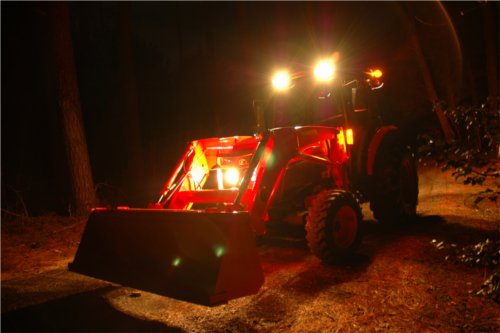
The heavy bucket with reinforced corners means Marshall can pop stumps and with a box blade on the back, he can regrade the farm lane with ease.
Marshall uses his equipment to service his 26 acre tree farm and also to clear the lane way for himself and his neighbors during the winter. In addition to the L5740 he also had his eye on the John Deere 4720, a 66 horsepower, 4 cylinder turbocharged diesel with similar hydrostatic transmission features as the Kubota (HST Plus vs. John Deere’s eThrottle and MotionMatch). Understandably he was torn and his friends were all either entirely from the orange or green camps.
From my discussion with Marshall there were three things that clinched the Kubota for him:
- A recommendation from a fellow respected contractor (who bleeds JD green) that John Deere is king of large equipment but the compact tractor experts are more of the orange variety.
- Feeling at home with the online information, schematics, and easy parts ordering offered by the biggest Kubota dealership in the United States – Messick’s.
- HST Plus with stall protection.
Marshall got back to me a few weeks later and added that part of his homework on the JD 4720 was running the tractor and engine serial numbers. The Deere had undergone a complete disassembly and reassembly along with a new hydro unit in only 500 hours of operation. Good call on the Kubota I would say!
Conclusion
The Grand L40 Series are Kubota’s premium L Series offering. Even entry or mid level models like the L3540 or L3940 are well appointed with standard features such as 4WD, differential lock, power steering and a wide seat and operator deck. If you want, the L5740 lets you pop stumps from the comfort of your air conditioned cab. Owners that opt for the HST transmission are receiving one of the most advanced HST solutions offered on the market today for a tractor of that size.
The entire Series is about customization. There are 5 engine choices, 3 transmission choices, 3 loader choices, 2 backhoe choices, multitudes of tire options and then after all of that you can ad a cab on top.
Kubota’s tag line for this Series? Life is Grand. What else is there to say?
Mr. K





